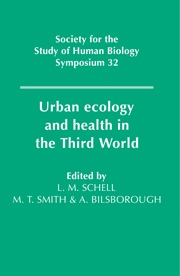Book contents
- Frontmatter
- Contents
- List of contributors
- Acknowledgements
- 1 Human biological approaches to the study of Third World urbanism
- 2 Social and cultural influences in the risk of cardiovascular disease in urban Brazil
- 3 The urban disadvantage in the developing world and the physical and mental growth of children
- 4 Differences in endocrine status associated with urban-rural patterns of growth and maturation in Bundi (Gende-speaking) adolescents of Papua New Guinea
- 5 Nutritionally vulnerable households in the urban slum economy: a case study from Khulna, Bangladesh
- 6 Urban-rural differences in growth and diarrhoeal morbidity of Filipino infants
- 7 Child health and growth in urban South Africa
- 8 From countryside to town in Morocco: ecology, culture and public health
- 9 Urban-rural population research: a town like Alice
- 10 Selection for rural-to-urban migrants in Guatemala
- 11 Health and nutrition in Mixtec Indians: factors influencing the decision to migrate to urban centres
- 12 Urban health and ecology in Bunia, N.E. Zaire, with special reference to the physical development of children
- 13 Food for thought: meeting a basic need for low-income urban residents
- 14 Immunological parameters in northeast Arnhem Land Aborigines: consequences of changing settlement patterns and lifestyles
- 15 Amerindians and the price of modernisation
- 16 Sex ratio determinants in Indian populations: studies at national, state and district levels
- 17 Polarisation and depolarisation in Africa
- 18 Urbanisation in the Third World: health policy implications
- Index
14 - Immunological parameters in northeast Arnhem Land Aborigines: consequences of changing settlement patterns and lifestyles
Published online by Cambridge University Press: 26 December 2009
- Frontmatter
- Contents
- List of contributors
- Acknowledgements
- 1 Human biological approaches to the study of Third World urbanism
- 2 Social and cultural influences in the risk of cardiovascular disease in urban Brazil
- 3 The urban disadvantage in the developing world and the physical and mental growth of children
- 4 Differences in endocrine status associated with urban-rural patterns of growth and maturation in Bundi (Gende-speaking) adolescents of Papua New Guinea
- 5 Nutritionally vulnerable households in the urban slum economy: a case study from Khulna, Bangladesh
- 6 Urban-rural differences in growth and diarrhoeal morbidity of Filipino infants
- 7 Child health and growth in urban South Africa
- 8 From countryside to town in Morocco: ecology, culture and public health
- 9 Urban-rural population research: a town like Alice
- 10 Selection for rural-to-urban migrants in Guatemala
- 11 Health and nutrition in Mixtec Indians: factors influencing the decision to migrate to urban centres
- 12 Urban health and ecology in Bunia, N.E. Zaire, with special reference to the physical development of children
- 13 Food for thought: meeting a basic need for low-income urban residents
- 14 Immunological parameters in northeast Arnhem Land Aborigines: consequences of changing settlement patterns and lifestyles
- 15 Amerindians and the price of modernisation
- 16 Sex ratio determinants in Indian populations: studies at national, state and district levels
- 17 Polarisation and depolarisation in Africa
- 18 Urbanisation in the Third World: health policy implications
- Index
Summary
Introduction
It is understood by all Australians that the health of Aboriginal people has suffered greatly as a result of European settlement and Westernisation. Morbidity and mortality statistics for Aborigines are considerably worse than for non-Aboriginal Australians: infant and perinatal mortality are approximately 2–4 times those of white Australians, with gastrointestinal infection a prime cause; hospital admissions for bacterial and parasitic infection and for respiratory disorders are approximately 5–7 times those of non-Aborigines; life expectancy for Aboriginal men and women is, on average, approximately 17 years less than for non-Aboriginal Australians (Thomson, 1991). While this has been acknowledged by the Australian government and increasing amounts of money and resources are being directed to Aboriginal health problems, ‘lifestyle diseases’ such as noninsulin- dependent (type 2) diabetes mellitus, cardiovascular disease and alchoholism have become particularly prevalent. Relatively little attention has been paid to the links between changing lifestyles (including settlement patterns, activity and nutrition), immune status, community health and health education, in the formulation of effective health services which take into account differences in cultural beliefs and practices.
There is considerable interest among immunologists and medical practitioners concerning the relationship between lifestyle and immune status: much research has demonstrated that nutritional status and immune responsiveness are strongly correlated (see, for example, Gershwin et al., 1985) and the recent emergence of ‘neuroimmunology’ clearly links emotional and physical ‘stress’ with changes in immune parameters (see, for example, Kelley, 1980).
- Type
- Chapter
- Information
- Urban Ecology and Health in the Third World , pp. 202 - 220Publisher: Cambridge University PressPrint publication year: 1993
- 7
- Cited by



